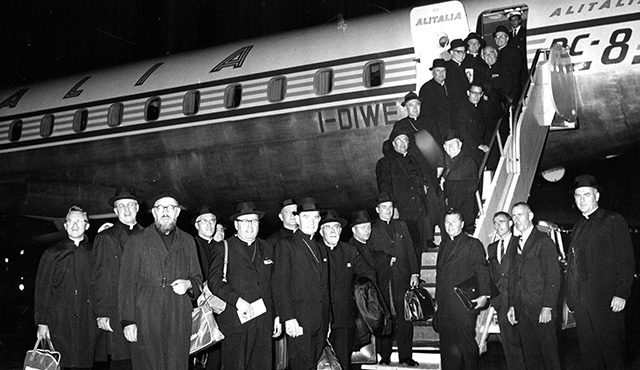WASHINGTON (CNS) — The U.S. Conference of Catholic Bishops arose out of a national crisis a century ago, when the U.S. entered the First World War.
In responding to this historic event, the Catholic Church sought how to best serve both its own people and the larger national community at a time of great need, and today the needs of the church and the common good at large continue to guide the USCCB and those who work for it.
As national mobilization moved ahead in 1917 following U.S. entry into the war, the American bishops established the National Catholic War Council to coordinate Catholic responses to the emergency.
In the months that followed, the council’s efforts included recruiting military chaplains, promoting recreational services for servicemen, and, via a women’s committee, encouraging war-related activities focusing on displaced persons and child welfare.
“The bishops felt they wanted to make sure they were directing the Catholic effort and not just kind of watch it take place,” Bishop Earl A. Boyea of Lansing, Michigan, told Catholic News Service.
“And, the best way to do that was to get all of the bishops together to figure out how we act as a national group of bishops to help lead Catholic efforts in various areas of needs regarding our own country,” he said in an interview during the USCCB’s July convocation.
After the war, the bishops decided to continue and expand their collaboration on the national level.
In a letter to the Vatican, Cardinal James Gibbons of Baltimore, the hierarchy’s de facto leader, said the bishops sought to create “a unified force … directed to the furthering of those general policies which are vital to all.”
Pope Benedict XV approved the plan for a permanent organization to be called the National Catholic Welfare Conference, the precursor to the USCCB, whose mission remains the same a century later.
Declaring “social justice and a contented people” to be the “only safeguard of peace,” it urged policies — now generally taken for granted but decidedly forward-looking at the time — that included minimum wage legislation; government-sponsored health and old age insurance; tough child labor laws; wage equality for women; and strict anti-monopoly enforcement.
Msgr. John A. Ryan, a professor of political economy and moral theology at The Catholic University of America, drafted the document. The priest came to head the NCWC social action department for the next quarter-century.
NCWC soon became a strong and effective voice for the U.S. church articulating Catholic views on a variety of issues.
At its headquarters in Washington, the NCWC had departments for education, legislation, social action, lay organizations, and press and publicity, along with a bureau for assistance to immigrants and an international news agency serving the Catholic press. NCWC provided information and resources to help counterpart offices in dioceses in their work, and served frequently as a model for the establishment of similar conferences of bishops in other countries.
During World War II, they established Catholic Relief Services to provide material assistance to refugees and people in war-torn nations. Today CRS, based in Baltimore, remains a major source of relief and development aid in many parts of the world. In the Cold War years, anti-communist education and action were features of many NCWC programs.
Vatican II (1962-65) in its Decree on the Pastoral Office of Bishops commended existing bishops’ conferences, urged that conferences be established in places where they did not yet exist, and sketched their functions.
In 1966, the U.S. bishops replaced the NCWC with a dual structure: the National Conference of Catholic Bishops, for canonical, doctrinal and church life affairs; and the U.S. Catholic Conference, for temporal concerns. Programs of the old NCWC were continued and new ones were added.
The NCCB dealt with matters such as doctrine, liturgy, canon law, seminaries, priestly life and ministry, religious life, the permanent diaconate, ecumenical and interreligious affairs, pro-life activities, and others. The USCC reflected the Catholic Church’s engagement with the world in the areas of education, social justice, and communication.
In the years immediately after Vatican II, much of the work of the NCCB and USCC focused on carrying out changes flowing from the ecumenical council or dictated by changing conditions in secular society.
Following the Supreme Court’s 1973 Roe v. Wade decision legalizing abortion, pro-life education and advocacy became even higher priorities for the hierarchy. The bishops also established a major new domestic anti-poverty program, the Catholic Campaign for Human Development. The 1980s brought widely discussed collective pastoral letters — “The Challenge of Peace” (1983) and “Economic Justice for All” (1986).
After extensive study, planning and discussion, the bishops adopted a restructuring plan that combined the NCCB and USCC into the present USCCB in 2001.
Today’s USCCB mirrors the vision expressed by Cardinal Gibbons when he told the Vatican of the formation of a bishops’ committee on “General Catholic Interests and Affairs” to plan a permanent national structure for the hierarchy. There was general agreement among the bishops that the church needed such a body to present its interests and better serve the nation, the cardinal wrote.
“From that moment of tragedy and national and worldwide challenge in 1917, came this magnificently unified credible voice with greater amplification in the national and worldwide scene,” said New York Cardinal Timothy M. Dolan.

